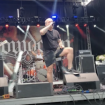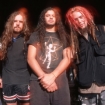"You only get so many shots in this life — and you gotta make it count."
Sepultura's shot came in 1988. And founding singer-guitarist Max Cavalera was dead set on hitting his target. Back then, the Brazilian band was a rising extreme-metal force with two albums under their bullet belts — but little recognition outside of their home country. Thanks to Cavalera's boundless ambition to break out, he marshaled all his resources, called in favors and worked his tape-trading connections to score him a plane ticket to New York City and face time with industry tastemakers and label reps. His hustle paid off when Roadrunner Records' Monte Connor offered his band a record contract. The new deal meant that Sepultura's music would reach a lot more people. For the then-broke act from Belo Horizonte, the stakes couldn't have been higher.
"We knew in our heart it was our shot — a make-it-or-break-it album," Cavalera continues. "If we would have released something shitty and nobody cared that would be the end of it. Done deal. We needed to step up on the music side, and we did."
The resulting album, 1989's Beneath the Remains, made good on their ambitions. The nine-song effort bursts with raw fury and breakneck death-thrash, and catapulted Sepultura onto the international stage. (The record has since gone on to become one of the Eighties most celebrated thrash releases.) Cavalera and Co. also levelled up their album-art game on Beneath the Remains — with a little help from renowned sci-fi and fantasy artist Michael Whelan.
"I discovered Michael Whelan from a series of paperback H.P. Lovecraft books that I found in Brazil," Cavalera says. "I suggested to Monte that we should try and get in touch with this guy for the cover. Then when Monte got a hold of Michael, Michael sent him a bunch of different paintings, including Beneath the Remains."
While the Whelan artwork Cavalera initially wanted to use was nixed by Roadrunner (and eventually used for labelmates Obituary's 1990 album Cause of Death), the singer ultimately agreed that the label's pick — a surreal red-and-black skull painting titled "Nightmare in Red" — "fit the record better." And though Whelan hadn't heard of Sepultura before Roadrunner approached him, when he finally met Cavalera, and listened to Beneath the Remains, the connection was instant — and visceral.

"My first impressions were, 'Hey, this guy is someone who'd be cool to work with,'" says Whelan. "I can tell you that I identified right away with the energy and outrage inherent in the music they did … I liked [Beneath the Remains,] it felt like I got my senses woken up! The intensity and energy blew me away."
Beneath the Remains kicked off a fruitful collaboration between Cavalera and Whelan, which resulted in classic album covers for Sepultura's Arise, Chaos A.D. and Roots. On the eve of Beneath the Remains' 31st anniversary, we asked Whelan about his early days working with Sepultura, the dark personal inspiration behind Beneath the Remains' iconic skull painting, his biggest regret about Roots and more.
YOU WERE ALREADY A WORLD-RENOWNED SCIENCE FICTION AND FANTASY ARTIST BEFORE SEPULTURA APPROACHED YOU FOR BENEATH THE REMAINS. IN TERMS OF DEVELOPING YOUR OWN STYLE, WHICH VISUAL ARTISTS MOST INSPIRED YOU AND WHY?
MICHAEL WHELAN I'm not sure how to answer that question. I never considered the idea of "developing a style." It was always a matter of just trying to visualize the things I wanted to express in the best way I could figure out.
Looking back at my development as a visual artist I can see how different artists affected me at different times of my life, but it would be hard to pick which ones most influenced me, for they were only a part of the visual information I was taking in when I was young. I was drawn to all sorts of things: TV shows, movies, books about the natural sciences, comic books, and human anatomy, etc. The earliest drawings I remember doing were recreations of scenes from [science fiction] movies I had liked, and imaginary landscapes on other worlds. But as I got older, I favored drawing elements from comic books and stories I had read, as a way of bringing them to visual life, so to speak. But from my earliest times I was making up my own images too, coming up with creatures, scenes and characters of my own.
As I came across things which I thought reflected my interests or simply looked cool, it was perceived and registered in my brain in some way – whether it was an illustration, experience, or mental picture inspired by something I read ... or dreams, for that matter.
Early in my childhood, I looked and admired paintings on fantasy and science fiction books, so all those artists were an early influence I'm sure. I used to gaze in wonder at the space exploration paintings of Chesley Bonestell and others attempting to visualize the future of space travel. When I was in my teens, [Frank] Frazetta and his contemporaries excited me a lot, but so did Norman Rockwell, Andrew Wyeth and the Golden Age illustrators such as [Maxfield] Parrish, [Arthur] Rackham and others. And in the late Sixties into the Seventies I was taken by the Pre-Raphaelites, Visionary artists and Decadent artists of the turn of the last century, as well as M.C. Escher and [René] Magritte. So how do I choose?
For the past few decades, of course, the largest influence on me is whatever I've done in my last few works. I usually react to previous work, so I'm often ping-ponging from large to small pieces, or from figures to imaginary landscapes, etc.
YOU'D WORKED WITH THE JACKSON 5 ON THE COVER ART FOR 1984's VICTORY, BUT SEPULTURA WAS YOUR FIRST COLLABORATION WITH A HEAVY-METAL BAND, RIGHT? DID YOU CONNECT AT ALL WITH SEPULTURA'S MUSIC, OR HEAVY METAL IN GENERAL?
I'd say I've always liked heavy music, but that means different things to different people. I hadn't heard Sepultura's music before the record company contacted me, but I liked what I heard before I agreed to have my artwork associated with them.
DID MUSIC PLAY A BIG PART IN YOUR CREATIVE WORK BACK IN THOSE DAYS? DID YOU LISTEN TO MUSIC WHILE YOU WORKED?
Always. I like a wide range of music, from symphonic to experimental electronic music to punk to hardcore to many of the popular bands during the Sixties through the Nineties. I often listen to hours of arranged sound effects, and I've created synth environments of my own to listen to when I wanted to emulate a specific mood of some otherworldly place. I can't get into operatic singing or country music, though ... makes my skin crawl.
My choices are often dictated by what kind of energy level I want in the studio when I'm into it. I usually have a dip of energy in the afternoon so that's the most likely time when you'll hear Sepultura, Suicidal Tendencies or the Exploited or whatever cranking out in the place. Too many artists to mention, though I will single out electronic musician Steve Roach as a big influence on my gallery work, especially in the late Nineties/early 2000s.
WHAT WERE YOUR THOUGHTS WHEN YOU FIRST LISTENED TO BENEATH THE REMAINS?
I liked it, felt like I got my senses woken up! The intensity and energy blew me away.
It's not my favorite kind of singing but the message determines the approach, so it fits well. Some thoughts and emotions require shouting!
MAX CAVALERA SAID HE FIRST DISCOVERED YOUR WORK IN A BOOK HE FOUND BACK IN BRAZIL. THIS LED HIM TO EVENTUALLY ASK ROADRUNNER TO APPROACH YOU. WHAT WERE YOUR FIRST IMPRESSIONS OF MAX?
My first impressions were, "Hey, this guy is someone who'd be cool to work with."
I can tell you that I identified right away with the energy and outrage inherent in the music they did, and that hasn't changed. I won't name names here, but man, I've dealt with guys lost in the labyrinths of their own egos and Max was a refreshing change from all that bullshit. And god, the shows are awesome. I've only seen two but they're unforgettable. "Refuse/Resist" [from 1993's Chaos A.D.] is like an anthem for me.
WHAT WAS THE EXPERIENCE LIKE WORKING WITH SEPULTURA VERSUS, SAY, THE JACKSON 5?
You're talking about two different universes here. Although the Jacksons treated me very respectfully, the record companies were hugely different. Much of the Jacksons' painting was done on a stove in a hotel room in Hollywood, under a very tight deadline, so it wasn't much fun to work on. Roadrunner was great, no hassle. I had a much greater instant rapport with Max, too.
SEPULTURA INITIALLY WANTED TO USE YOUR ARTWORK FROM H.P. LOVECRAFT'S "BLOODCURDLING TALES OF HORROR AND THE MACABRE" — WHICH ULTIMATELY WAS USED FOR OBITUARY'S CAUSE OF DEATH ALBUM. WAS "BLOODCURDLING…" ORIGINALLY COMMISSIONED BY H.P. LOVECRAFT'S TEAM?
Well, it was commissioned by the publisher of the books. They told me "Hey, we have seven [H.P. Lovecraft] books we want to publish but a budget for only two cover paintings. Got any ideas?" So I painted a couple of panels full of macabre imagery and told them they could take what they wanted to use out of the artwork for the covers and that worked out pretty well. A lot of people saw those book covers and wanted to use the artwork for album covers, but Obituary got there first!
CAN YOU DESCRIBE THE INSPIRATION/THOUGHT PROCESS BEHIND "BLOODCURDLING"? IT'S AN INCREDIBLE SCENE THAT YOU CREATED.
I covered all my studio windows with aluminum foil to shut out the cheery May sunshine. While playing some dark industrial music I just went right into the painting, no preparation or anything. I used an airbrush to create clouds of dark diffuse shapes on the panels then painted things that appeared to me in my mind's eye, so to speak. As I worked on it, I gradually switched from larger brushes to smaller ones, allowing me to get into more detail.
SEPULTURA ENDED UP USING "NIGHTMARE IN RED" FOR BENEATH THE REMAINS. CAN YOU TALK ABOUT THE INSPIRATION BEHIND THAT PAINTING?
I had been commissioned to do a cover for a collection of horror stories, but it was a freaky time for me to tackle such an assignment. The month before my mother had died of cancer, John Lennon had been shot, and two friends of the family were killed in a car accident. When I got to thinking about painting and closed my eyes, all I could see was this floating red shape against a field of black. It seemed to represent my state of mind at the time, so I started from that. As I worked on it, it evolved into a skull with symbolic shapes mixed into the composition. That worked for me as well as providing an appropriate image for the book cover I was commissioned to do, so it was an ideal solution for that time.
"NIGHTMARE IN RED" IS ACRYLICS OVER PASTELS — CAN YOU DESCRIBE THE CREATIVE PROCESS THAT RESULTED IN THIS PIECE?
When I started it I just wanted to get the redness onto a black background as quickly as possible. I remembered that I had some black pastel paper in a drawer, so I thought the easiest way to do that was to use red pastel on the black paper and go from there. As it turned out, the paper was more of a dark gray than a really deep black, so I had to go over most of the piece with acrylic paint — first using black over the areas I wanted to be really dark, and red and other colors for the stuff in the foreground.

THIS PIECE, AS WELL AS SOME OF YOUR OTHER HORROR WORK, HAS A REALLY DARK VIBE TO IT. DO YOU GO TO A DARK PLACE WHEN YOU CREATE? DOES THAT EVER TAKE ITS TOLL ON YOU?
I think I answered the first part of this question already. As for it taking a toll on me, as you put it, it's actually the opposite: I find it cathartic. When I get all worked up about the news, the state of world affairs and the awful things people do to each other, there's no tonic for me better than doing a metal cover painting or some horror piece. Keeps me sane! Chaos A.D. was especially good for me, came at the perfect time to capture the anxiety and feeling of struggle against the negative authority figures I was feeling at the time.
BENEATH THE REMAINS BEGAN A LONG PARTNERSHIP WITH MAX AND SEPULTURA, WHICH RESULTED IN A LOT OF ICONIC ALBUM COVERS LIKE ARISE, CHAOS A.D. AND ROOTS. DO YOU HAVE A PERSONAL FAVORITE, AND WHY?
Chaos A.D. is my favorite, partially for the reason mentioned above. Also, it was an entirely experimental painting approach for me, using all kinds of crazy techniques I'd never used before or since! Roots is one of my favorite albums, but not my favorite cover by a long shot — mostly because it relied too much on digital crap — not anyone's fault but mine. I should have painted it in oils or whatever instead of trying to do it digitally. My studio computer system went completely nuclear, so I had to drive an hour every morning to a fellow artist's studio and use his equipment to get the thing done, which was a real pain in the ass.
The music on the album was great, so I would have liked to have done an image that really did it justice. Max had a very set idea of what he wanted on the cover however, so I didn't have a lot of choice in the matter, to be honest. If I had to do it over again I'd probably paint something different while trying to keep the same vibe.








